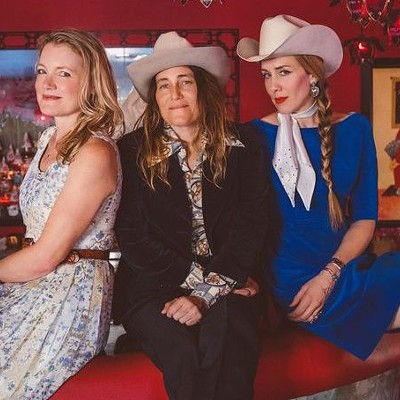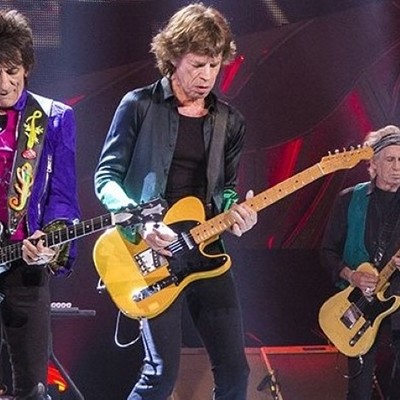While tracing the music’s history from founder Clifton Chenier’s days in the Fifth Ward and his seminal recordings at Gold Star Studios, Houston Community College professor Dr. Roger Wood and photographer James Fraher address these misconceptions and profile many of the Houston area’s leading zydeco figures in their 2006 book Texas Zydeco, and at 7 p.m. tonight a half-hour film based on the book premieres at HCC’s Heinen Theater, 3517 Austin at Holman. (It’s free, but admission is limited to the first 300 people.) An encore will be shown at 10 a.m. tomorrow at the San Jacinto Auditorium, 1300 Holman, with Wood and Fraher fielding questions from the audience afterward. Houstoned Rocks sat down with the pair, who also collaborated on the 2003 local blues history Down in Houston, yesterday to discuss the film and all things zydeco; here are a few excerpts from our conversation.
Oh, and don’t worry if you can’t make the screenings, either. Wood says Texas Zydeco, which mixes interviews, performance footage and commentary, will be showing “almost perpetually” on HCC-TV, Comcast channel 19, in the near future.
Houstoned Rocks: Was there always a plan to do a film as a companion to the book?
James Fraher: What [director Ruben Duran] originally wanted to do was some kind of podcast.
Dr. Roger Wood: Ruben [a former student and now colleague of Wood’s], in my opinion, he was the initial interest in doing this. Part of this is Ruben, even though his background is meringue and salsa and stuff like that, he digs music on such a level, you know, and he met T-99 and some of those cats and came to some of the things I did at the El Dorado Ballroom. [Late local bluesman Jimmy “T-99” Nelson is prominently featured in Down in Houston, from which Duran also made a companion film.] I think he was just driven by a sense of honoring the book and honoring Jim’s work – he loves Jim’s photography, of course – and honoring the music. I think that’s the thing that drove this forward.
HR: Who are a few of the people featured in the movie?
JF: Step Rideau.
RW: Step Rideau’s in it prominently. Brian Jack & the Zydeco Gamblers – he’s one of the younger guys. He’s just 22. He’s really great. Step’s established; he’s in his 40s now.
JF: Performing, Willie T.
RW: Wilfred Chevis. This young guy that’s in his early 20s, his name’s Robert Carter and they call him “Ra-Ra.” He performs in it and gets interviewed. Also, I’m really happy about this, and we did the same in our book, they don’t just talk to the accordion players, they talk to some scrubboard players and some dancers. In particular they talk to Ann Gustafson, who I believe is a librarian at Edgar Allan Poe Elementary, this very distinguished woman. Somehow she got turned on to zydeco. Jim and I started going out and photographing zydeco, and we saw her all over the city. All the people know her and love her.
JF: Robert Murphy.
RW: The first time Chris Strachwitz [founder of folk/roots label Arhoolie Records, which released Clifton Chenier’s first records and many other zydeco records] ever heard Clifton Chenier play was at this joint in Fifth Ward where it was just Clifton and a drummer. They were doing this low-down French blues, and it was Murphy on drums. Almost all that stuff Clifton did for Arhoolie in the ‘60s and ‘70s wasn’t recorded live, it was recorded in Houston, and almost all of it had Houston drummers and musicians on it.
HR: What narrative arc does this film trace?
RW: It tells the story of the music and its western movement out of Louisiana, and its fusion, the back-and-forth washing-machine mixture it’s been ever since then. That’s such a fundamental story that anyone who looks at the facts understands, but in popular perception it’s not understood. [People] think of zydeco as this idolized, rural Louisiana mystical music, and don’t understand that it’s an urban music whose urbanity primarily comes from this city right here.
That early Creole ‘la-la’ sound, as these immigrants migrated here to work in the ship channels and factories and stuff, left their sharecropping job and moved to neighborhoods like Fifth Ward, where they’re suddenly living near and socializing with regular Texas blacks who played jazz and blues back in the ‘40s and ‘50s. Now, for the first time, they’re living in an urban environment where they’re not in segregated Creole communities back in the parishes back home. They’re in this urban environment where they’re exposed to other blacks with other styles of music, and that fusion gets carried back home. The word itself, that spelling z-y-d-e-c-o was established here by my good friend Mack McCormick.
HR: Is there any reason you can think of why zydeco mixed so well with rap?
RW: I do have a theory about that. Zydeco is, and pretty much has been since it’s been called that, music that has actively involved every generation of black Creole culture. The kids hear it at the church dances. The old black Creole Catholic churches, this is the one city on Planet Earth where there’s a zydeco church dance – during Lent there aren’t any - most Saturday nights of the year. There’s like seven of them.
There’s this theme, there’s these multiple generations where people – actively in Houston, even with an artist who can be as hardcore as J. Paul or somebody, they’re still exposed to kids. When we were doing this blues work, the youngest people we encountered were people my age, and most of them were my dad’s age. But zydeco, if you go into a place like Mr. A’s [in Fifth Ward], it’s all 21 and up. A lot of those places where zydeco is performed for big audiences – at those church dances, at restaraunts, places like Jax Grill, before PT’s closed down – you’ve got little children down there. [To Fraher] How many times when we were photographing zydeco did you see a child with a plastic accordion?
JF: A lot.
RW: It’s this music, these people, even though a lot of it’s been lost to assimilation and time, they’ve got a distinctive language in the French expressions. Most of the blacks in Houston aren’t Catholic, but a lot of these zydeco people are. They’ve got all these things that bind the generations. Their food’s a little bit different, their music’s a little bit different.
Their music has always been, unlike your music or my music, when we were kids, whatever my music was, it was counter and opposite to what my dad’s music was. Zydeco has not only involved the kids, but it’s had room and elasticity enough, it’s been big enough. The first great zydeco fusion stuff happened in Houston in the ‘70s, the first after Clifton Chenier creates the genre by fusing blues and R&B with la-la, was the Sam Brothers 5, which was like this disco/Jackson 5 zydeco unit that used to play at roller rinks in Houston.
Then in the ‘90s, this guy who lives in Baytown, Brian Terry [Lil’ Brian], he was the first one to record that zyde-rap fusion. There was a brief burning period where that was the phenom. In fact, when we first started our book in summer 2003, the final chapter was about the whole zyde-rap thing, and we thought that’s where the story ends. But by the time we finished the book, we’ve seen that die and we’ve seen this remarkable neo-traditionalist thing spring up that just baffled us, where guys like Cedric Watson, this guy who was 19 when we first met him, grew up in San Felipe, plays fiddle and sings in French. Guys like Corey Ledet who went to Elkins High School, lived in Houston all his life, playing and sounding like Clifton Chenier, singing in French and doing old songs.
HR: Do you have any idea what spawned that?
RW: I think it was all part of this pendulum dynamic. A lot of zydeco people got disenchanted by the zydeco-rap thing. It seemed like all the young bands were doing that. In my opinion, that’s part of what hurt the church dances. The old sisters of the church didn’t want to hear that. There was a moment where the culture was big enough to tolerate it, but it wasn’t big enough for everyone to make a living. There was a negative reaction to that in the community. A lot of people didn’t like it.
HR: The same way some older black folks can’t tolerate hip-hop?
RW: Exactly. This is the big difference with your analogies between zydeco and blues or rock or anything else. Zydeco is, was and forever will be primarily dance music. And the deal with the zydeco rap kids was they’d go all night and never do a waltz. There were people there who were waiting for a waltz. Seriously, young and old, waltzing is part of zydeco, but with the zydeco-rap kids, it was basically two-step on speed all night long. Either that or it was that real slow, funky stuff like J. Paul would do sometimes, where it’s all bob your head, bob your head, bob your head. That Mr. A’s stuff, it was hard to call it zydeco. There was no zydeco dancing. That happened, and it worked for a while, but it’s definitely kind of crested. – Chris Gray






